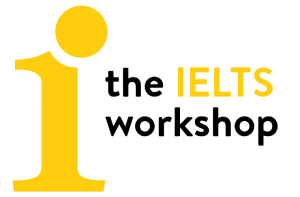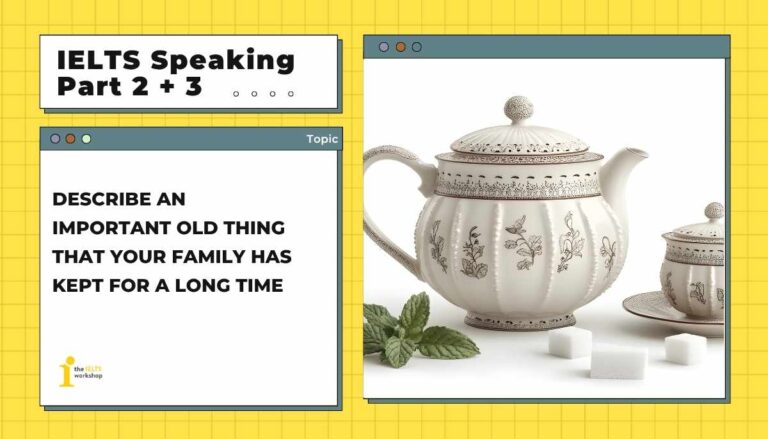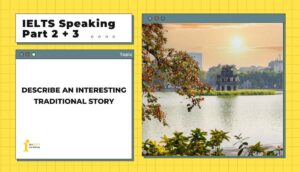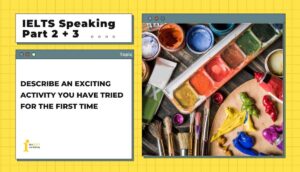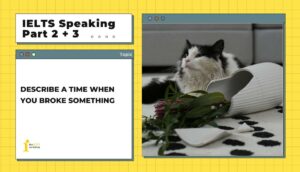Bài mẫu chủ đề “Describe an important old thing that your family has kept for a long time” của giáo viên Lê Thị Minh Huyền cung cấp ý tưởng mạch lạc, từ vựng đa dạng và chiến lược trả lời hiệu quả cho IELTS Speaking Part 2.
Part 2: Describe an important old thing that your family has kept for a long time
You should say:
- What it is
- How/when your family first got this thing
- How long your family has kept it
- And explain why this thing is important to your family
1. Bài mẫu (Sample)
Gợi ý triển khai câu trả lời với Storify arc (scene → trigger → challenge → resolution → reflection):
[Scene] I’m going to talk about a porcelain tea set that has been in my family for as long as I can remember. It’s delicately painted with blue peonies and comes in a slightly chipped wooden box that my great-grandmother brought with her when she moved to Hanoi after the war.
[Trigger] The set was originally purchased in the 1950s, when my great-grandparents scraped together their savings to buy something “proper” for hosting guests. Back then, tea wasn’t just a drink; it was a ritual that stitched the neighborhood together.
[Challenge] Over the years, a few cups cracked hairline-thin, and at one point we nearly retired the set for fear of damaging it further. However, during Tet two years ago, my grandmother insisted we bring it back into circulation, saying that objects kept behind glass eventually forget their purpose.
[Resolution] We now use it on high days and holidays—weddings, homecomings, and milestone birthdays. Pouring tea from that time-softened kettle, we trade family lore, and the set becomes a quiet stage for stories that might otherwise be lost.
[Reflection] We’ve kept it for roughly seven decades, and it matters not for its price tag, but for the way it anchors us to our roots. Whenever I lay out the cups—each one slightly imperfect—I’m reminded that enduring things rarely survive unmarked, and those small scars are exactly what make family traditions feel lived-in and real.
Sample band 7.5+ by Huyen Minh, IELTS Teacher at The IELTS Workshop
2. Từ vựng (Vocabulary)
- delicately painted → vẽ tinh xảo/nhã nhặn (mô tả thủ công mỹ nghệ).
- slightly chipped → sứt nhẹ (mô tả đồ cũ nhưng còn dùng).
- scraped together their savings → chật vật góp nhặt tiền tiết kiệm (sắc thái nỗ lực).
- a ritual that stitched the neighborhood together → nghi lễ kết nối xóm giềng (ẩn dụ “khâu kết”).
- cracked hairline-thin → nứt sợi tóc (vết nứt rất mảnh).
- bring it back into circulation → đưa vào dùng trở lại (ẩn dụ “lưu thông”).
- kept behind glass → cất sau tủ kính (chỉ để trưng) (hàm ý không dùng).
- time-softened (kettle) → ấm đã “mềm” theo thời gian (ẩn dụ thời gian làm dịu).
- trade family lore → kể qua lại chuyện gia đình truyền miệng.
- might otherwise be lost → nếu không thì có thể mất đi (nguy cơ thất truyền).
- not for its price tag → không phải vì giá tiền (đảo ngữ nhấn mạnh giá trị tinh thần).
- anchors us to our roots → neo chúng tôi vào cội nguồn (ẩn dụ “neo”).
- enduring things rarely survive unmarked → vật bền hiếm khi không mang dấu vết (châm ngôn nhẹ).
- feel lived-in and real → có cảm giác “được sống” và chân thật
Xem thêm: Cách học từ vựng IELTS hiệu quả từ thầy Đặng Trần Tùng 9.0
Part 3:
1. What kind of old things do people in your country like to keep?
In Vietnam, people usually keep items that carry family stories and social rituals. You often see porcelain tea sets and thick photo albums that come out on Tet or memorial days, which anchor shared memories and make tradition feel concrete. They also keep watches, school certificates, and old letters tied with ribbon; these mark personal milestones, so the object isn’t about price but about identity that can be passed from one generation to the next.
- porcelain tea sets: bộ ấm chén sứ truyền thống
- thick photo albums: album ảnh dày, lưu giữ ký ức
- anchor shared memories: neo giữ ký ức chung
- school certificates: bằng cấp, giấy khen
- old letters tied with ribbon: thư tay buộc ruy băng
- personal milestones: cột mốc quan trọng
- identity: bản sắc cá nhân truyền đời
2. Why do people keep old things?
People keep old things mainly for emotional continuity and cultural identity. A faded letter or a chipped bowl can instantly bring back a person or a moment, helping someone feel stable across time instead of constantly starting over. Old objects also signal values like thrift and craftsmanship, showing how families pass down practical wisdom.
- emotional continuity: sự nối dài cảm xúc
- cultural identity: bản sắc văn hóa
- chipped bowl: chiếc bát sứt
- stable across time: ổn định theo thời gian
- thrift: tiết kiệm
- craftsmanship: tay nghề thủ công
3. Differences between the things old people keep and those young people keep
Older people keep genealogy-focused items because these preserve lineage and duty. Younger people keep identity-focused items like concert wristbands, retro consoles, and digital photo archives because these reflect community, taste, and self-expression rather than ancestry.
- genealogy-focused items: vật liên quan gia phả
- lineage: dòng dõi
- identity-focused items: đồ thể hiện cá tính
- self-expression: tự thể hiện mình
- ancestry: tổ tiên, nguồn gốc
4. Differences between things people keep today and in the past
In the past, people kept durable, utilitarian goods like mechanical watches and handwritten letters because scarcity made objects precious. Today, people keep cloud photos, e-tickets, and limited-edition merchandise; digitization makes memories portable and searchable.
- durable, utilitarian goods: đồ bền, dùng thiết thực
- cloud photos: ảnh lưu trên đám mây
- limited-edition merchandise: đồ phiên bản giới hạn
- portable and searchable: dễ mang theo và dễ tìm
5. What can we see in a museum?
Museums present artifacts, fine art, and ethnographic collections, arranged with context panels and timelines. Many museums now include interactive exhibits and VR reconstructions to deepen visitor engagement.
- artifacts: hiện vật lịch sử
- ethnographic collections: bộ sưu tập văn hóa dân tộc
- context panels: bảng thông tin bối cảnh
- interactive exhibits: trưng bày tương tác
- VR reconstructions: tái dựng thực tế ảo
6. What can we learn from a museum?
Museums teach people to understand context, causality, and continuity. By comparing objects from different cultures, visitors build cross-cultural empathy and develop source literacy, helping them resist misinformation.
- context, causality, and continuity: bối cảnh – nguyên nhân – dòng chảy
- cross-cultural empathy: thấu cảm liên văn hóa
- source literacy: khả năng đánh giá nguồn thông tin
- misinformation: thông tin sai lệch
Tạm kết
Hy vọng bài mẫu trên đã giúp bạn hình dung rõ cách triển khai ý tưởng và sử dụng ngôn ngữ phù hợp khi gặp chủ đề Describe an important old thing that your family has kept for a long time trong IELTS Speaking Part 2 & 3. Tham khảo các nguồn tài liệu hữu ích như KHO BÀI MẪU IELTS SPEAKING và Bộ đề dự đoán IELTS Speaking cập nhật mới nhất.
HỌC IELTS MIỄN PHÍ – lớp học độc quyền chỉ có trên website của The IELTS Workshop. Đăng ký để bắt đầu lộ trình học bài bản cùng thầy cô tại TIW ngay nhé!

